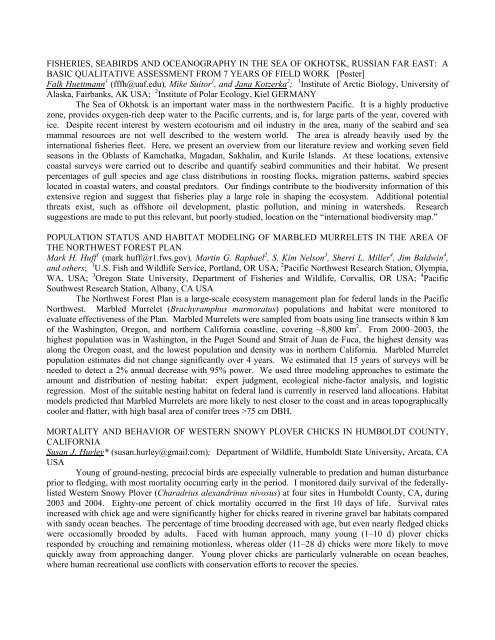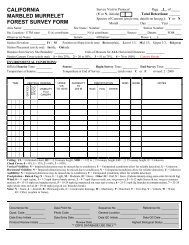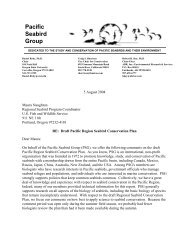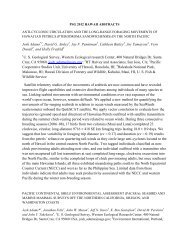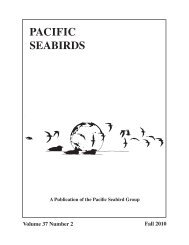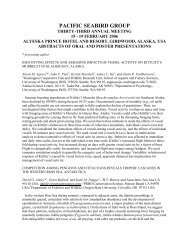abstracts of oral and poster presentations - Pacific Seabird Group
abstracts of oral and poster presentations - Pacific Seabird Group
abstracts of oral and poster presentations - Pacific Seabird Group
Create successful ePaper yourself
Turn your PDF publications into a flip-book with our unique Google optimized e-Paper software.
FISHERIES, SEABIRDS AND OCEANOGRAPHY IN THE SEA OF OKHOTSK, RUSSIAN FAR EAST: A<br />
BASIC QUALITATIVE ASSESSMENT FROM 7 YEARS OF FIELD WORK [Poster]<br />
Falk Huettmann 1 (fffh@uaf.edu), Mike Suitor 1 , <strong>and</strong> Jana Kotzerka 2 ; 1 Institute <strong>of</strong> Arctic Biology, University <strong>of</strong><br />
Alaska, Fairbanks, AK USA; 2 Institute <strong>of</strong> Polar Ecology, Kiel GERMANY<br />
The Sea <strong>of</strong> Okhotsk is an important water mass in the northwestern <strong>Pacific</strong>. It is a highly productive<br />
zone, provides oxygen-rich deep water to the <strong>Pacific</strong> currents, <strong>and</strong> is, for large parts <strong>of</strong> the year, covered with<br />
ice. Despite recent interest by western ecotourism <strong>and</strong> oil industry in the area, many <strong>of</strong> the seabird <strong>and</strong> sea<br />
mammal resources are not well described to the western world. The area is already heavily used by the<br />
international fisheries fleet. Here, we present an overview from our literature review <strong>and</strong> working seven field<br />
seasons in the Oblasts <strong>of</strong> Kamchatka, Magadan, Sakhalin, <strong>and</strong> Kurile Isl<strong>and</strong>s. At these locations, extensive<br />
coastal surveys were carried out to describe <strong>and</strong> quantify seabird communities <strong>and</strong> their habitat. We present<br />
percentages <strong>of</strong> gull species <strong>and</strong> age class distributions in roosting flocks, migration patterns, seabird species<br />
located in coastal waters, <strong>and</strong> coastal predators. Our findings contribute to the biodiversity information <strong>of</strong> this<br />
extensive region <strong>and</strong> suggest that fisheries play a large role in shaping the ecosystem. Additional potential<br />
threats exist, such as <strong>of</strong>fshore oil development, plastic pollution, <strong>and</strong> mining in watersheds. Research<br />
suggestions are made to put this relevant, but poorly studied, location on the “international biodiversity map.”<br />
POPULATION STATUS AND HABITAT MODELING OF MARBLED MURRELETS IN THE AREA OF<br />
THE NORTHWEST FOREST PLAN<br />
Mark H. Huff 1 (mark huff@r1.fws.gov), Martin G. Raphael 2 , S. Kim Nelson 3 , Sherri L. Miller 4 , Jim Baldwin 4 ,<br />
<strong>and</strong> others; 1 U.S. Fish <strong>and</strong> Wildlife Service, Portl<strong>and</strong>, OR USA; 2 <strong>Pacific</strong> Northwest Research Station, Olympia,<br />
WA, USA; 3 Oregon State University, Department <strong>of</strong> Fisheries <strong>and</strong> Wildlife, Corvallis, OR USA; 4 <strong>Pacific</strong><br />
Southwest Research Station, Albany, CA USA<br />
The Northwest Forest Plan is a large-scale ecosystem management plan for federal l<strong>and</strong>s in the <strong>Pacific</strong><br />
Northwest. Marbled Murrelet (Brachyramphus marmoratus) populations <strong>and</strong> habitat were monitored to<br />
evaluate effectiveness <strong>of</strong> the Plan. Marbled Murrelets were sampled from boats using line transects within 8 km<br />
<strong>of</strong> the Washington, Oregon, <strong>and</strong> northern California coastline, covering ~8,800 km 2 . From 2000–2003, the<br />
highest population was in Washington, in the Puget Sound <strong>and</strong> Strait <strong>of</strong> Juan de Fuca, the highest density was<br />
along the Oregon coast, <strong>and</strong> the lowest population <strong>and</strong> density was in northern California. Marbled Murrelet<br />
population estimates did not change significantly over 4 years. We estimated that 15 years <strong>of</strong> surveys will be<br />
needed to detect a 2% annual decrease with 95% power. We used three modeling approaches to estimate the<br />
amount <strong>and</strong> distribution <strong>of</strong> nesting habitat: expert judgment, ecological niche-factor analysis, <strong>and</strong> logistic<br />
regression. Most <strong>of</strong> the suitable nesting habitat on federal l<strong>and</strong> is currently in reserved l<strong>and</strong> allocations. Habitat<br />
models predicted that Marbled Murrelets are more likely to nest closer to the coast <strong>and</strong> in areas topographically<br />
cooler <strong>and</strong> flatter, with high basal area <strong>of</strong> conifer trees >75 cm DBH.<br />
MORTALITY AND BEHAVIOR OF WESTERN SNOWY PLOVER CHICKS IN HUMBOLDT COUNTY,<br />
CALIFORNIA<br />
Susan J. Hurley* (susan.hurley@gmail.com); Department <strong>of</strong> Wildlife, Humboldt State University, Arcata, CA<br />
USA<br />
Young <strong>of</strong> ground-nesting, precocial birds are especially vulnerable to predation <strong>and</strong> human disturbance<br />
prior to fledging, with most mortality occurring early in the period. I monitored daily survival <strong>of</strong> the federallylisted<br />
Western Snowy Plover (Charadrius alex<strong>and</strong>rinus nivosus) at four sites in Humboldt County, CA, during<br />
2003 <strong>and</strong> 2004. Eighty-one percent <strong>of</strong> chick mortality occurred in the first 10 days <strong>of</strong> life. Survival rates<br />
increased with chick age <strong>and</strong> were significantly higher for chicks reared in riverine gravel bar habitats compared<br />
with s<strong>and</strong>y ocean beaches. The percentage <strong>of</strong> time brooding decreased with age, but even nearly fledged chicks<br />
were occasionally brooded by adults. Faced with human approach, many young (1–10 d) plover chicks<br />
responded by crouching <strong>and</strong> remaining motionless, whereas older (11–28 d) chicks were more likely to move<br />
quickly away from approaching danger. Young plover chicks are particularly vulnerable on ocean beaches,<br />
where human recreational use conflicts with conservation efforts to recover the species.


